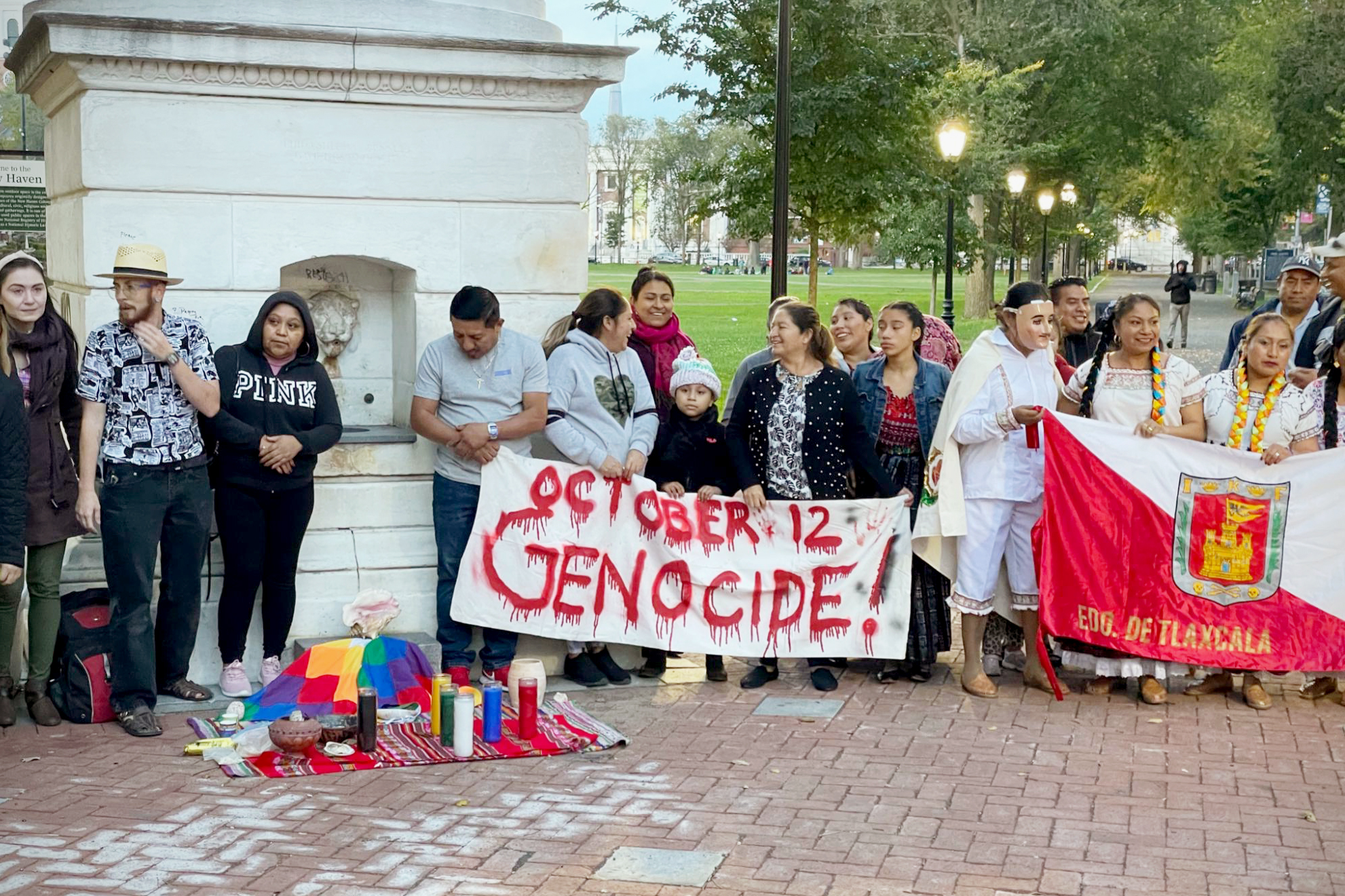Remembrance and reflection on Day of Indigenous Resistance
Unidad Latina en Acción and community members organized their 10th annual Indigenous Resistance Day celebration in New Haven, which took place on the Green on Wednesday.

Hanwen Zhang, Contributing Photographer
New Haven residents gathered on the Green Wednesday evening in a demonstration of resistance to colonialism on the Day of Indigenous Resistance.
The gathering organized by Unidad Latina en Acción brought together dancers, speakers and community members of all ages at the corner of New Haven’s Green. The event featured dances, speeches and ceremonies that reflected on the legacies of colonialism and genocide in the Americas.
“We’re here to stay,” said John Lugo, the community organizing director of ULA. “Even in New Haven, we belong to this land.”
Lugo emphasized the significance of the event’s location, explaining that the event was being held on the same field where the head of a Quinnipiac man was once hung on a stake.
In ULA’s tenth annual Day of Indigenous Resistance event, speeches and performances focused on themes of cultural preservation, belonging and immigration. The event began with community members burning incense and colored candles, which they said symbolized the earth, water, the sun and home.
Pero Lopez, who is from Guatemala, took up the microphone to remind the audience of the deep roots of his Indigenous heritage.
“We come from rich culture, we are not to have shame on our language, our people,” Lopez said.
He called on members of the crowd to honor those who had lost their lives by protecting their land, leading the candle-lighting ceremony to “invoke… the people we have lost” and find “the strength of a new tomorrow.”
“This is a day of vindication, of taking back the languages and culture and way of life that has been destroyed,” Lopez said.
Lugo added that the group refuses to celebrate Columbus Day and honor a holiday “that has anything to do with colonization in this land.” He affirmed ULA’s support for all “all Indigenous peoples from Alaska to Argentina” in their struggle for self-determination and culture.
The ceremony was followed by a suite of traditional dances. “Las Chapinas”, an Indigenous dance group hailing from San Marcos, Guatemala, performed first. One of the dancers shared a few words in both Spanish and in the Mayan language Mam, urging her listeners to preserve their traditions and expressing her pride as an Indigenous woman.
The second group, “Culturas del Pasado, Voces del Presente” danced and sang Nahua songs. Based in Tlaxcala, Mexico, its members are currently touring America as part of a project to reunite families separated at the border.
For organizers, the event was also meant to show the inseparability of indigeneity from immigration.
“All of us migrants are part of this land,” Lugo said in his speech.
He pointed out the irony in how colonial forces that had caused the “rape and the destruction of cultures” now defended their territory through stereotypes of the “illegal” immigrant. The genocide continues, he explained, when borders are drawn and the policies of powerful countries force Indigenous people to migrate.
“[The Democrats] promised they were going to pass this legalization for everybody. And basically […] we’re going to have nothing at the end of this Biden administration,” Lugo added.
Indigenous Resistance Day has been celebrated widely in Venezuela since 2002, acknowledging indigenous culture and resistance to Spanish settlement.
Meanwhile, Indigenous Peoples’ Day, which honors Native American people and culture in the US, has yet to become an official federal holiday — it remains designated under Christopher Columbus’ name — though two bills in both the U.S. House and Senate are working to change that. Joe Biden formally recognized the day last year, and more than 130 cities have adopted the holiday nationwide. In New Haven, it was made official in 2020.
This was local resident Robert Menefee ’79’s second Day of Indigenous Resistance celebration on the Green. Like many, he had learned of Columbus as a “hero” in school.
“But then I found out later, and… it’s good that we don’t celebrate [the day],” Menefee said.
Just a block away, celebrations kicked off last Monday with pictures, a musical performance by student drum group Red Territory and a round dance in front of the Sterling Memorial Library, sponsored by the Native and Indigenous Students Association at Yale.
“I would say that Indigenous People’s Day is a solemn day because it reflects on a history of centuries of violence and colonial project genocide,” said NISAY chair Joaquín Lara Midkiff ’23.
However, there was just as strong a sense of hope. Mara Gutierrez ‘25, NISAY co-bonding coordinator, added that it was a chance to “be in community with each other.”
“IPD is also a day of joy and celebration… I think Indigenous joy is a component of resistance to … the normative powers that be,” Lara Midkiff said. “It is a good day, no matter how you slice it.”
Indigenous People’s Day was first proposed at the 1977 conference of the United Nations.







